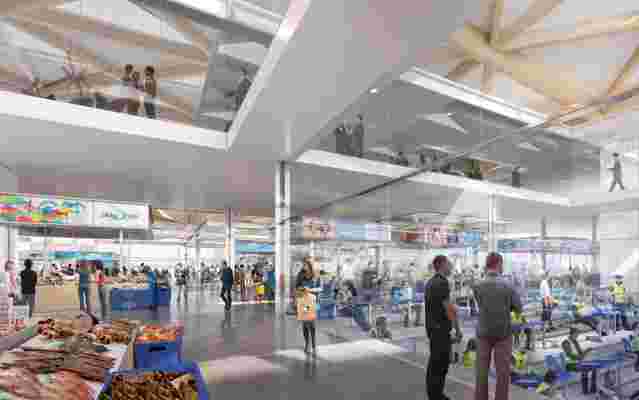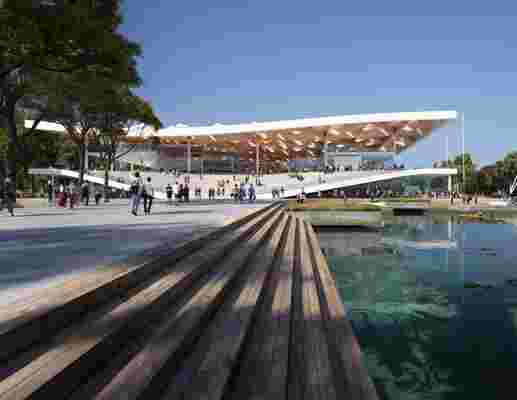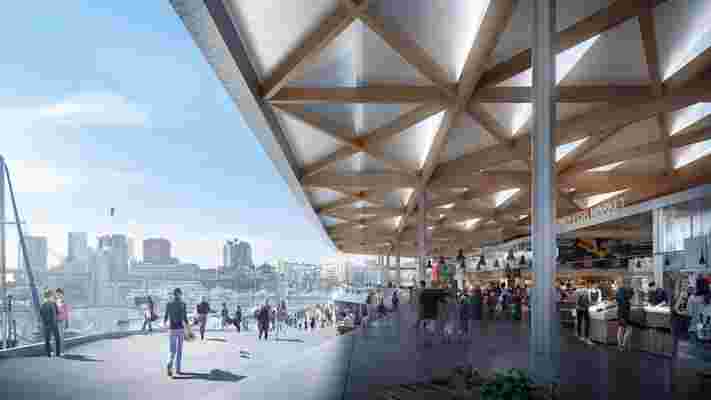When you first look at renderings of Sydney’s upcoming fish market, the undulating white structure looks like a concert hall or perhaps a convention center rather than the Southern Hemisphere’s largest sales arena for all things seafood-related. When completed, the newly renovated fish market will be a fresh addition to the existing market, which has been there since it was first recognized in 1945. The existing market sells more than 25 million pounds of seafood each year to consumers and distributors (making it the world's third-largest fish market), but it’s also one of Sydney’s largest tourist attractions, drawing more three million visitors each year. The popularity has prompted New South Wales to make a $250 million investment into the aging market, replacing the old space with a hybrid retail and community destination set on nine acres, with landscaping and outdoor spaces that integrate the adjacent Blackwattle Bay.
“This building will be many things when it is done: a working fish market, an amenity for the city, a cultural destination, an urban connector, and an inspiring icon along the world-renowned Sydney Harbour,” explains Kim Herforth Nielsen, founding partner of 3XN, the Copenhagen-based firm behind the new design. The current market contributes more than $21 million annually to New South Wales’s economy, in addition to $72 million in value-added spending by tourists. Nearly 70 percent of international visitors said that the Sydney Fish Market was a factor for their decision to visit the city, according to an independent report commissioned by the market.

Patrons of the market will be able to buy produce while safely standing above the docks where the fish will be brought in.
The new design aims to better integrate these visitors into the busy building while recognizing the safety and operational challenges that come along with keeping a bustling wholesale market open to the public. The concept of 3XN contains much of the site’s action—loading docks and the wholesale market—to the ground floor, with amphitheater staircases and promenades towering over the working wharf, giving visitors a visual connection to the site but keeping them safe and separate from heavy machinery and other hazards. There will also be an expanded seafood-focused cooking school, food kiosks, restaurants, bars, and outdoor areas for social events.

The structure will come right up to the water, allowing visitors and tourists to enjoy the natural beauty of Sydney's waterfront.
The plans integrate the water’s edge through the construction of plazas at either end of the market. With an eye toward sustainability, these plazas will house wetland flora that serves to filter stormwater and gray water from the building, a design feature that 3XN says could even serve as protective habitat for local birds in the future.
But with our oceans becoming depleted at an alarming rate, will construction of the new market promote conservation or only serve to encourage further overfishing and unethical consumption? Research supports the fact that fish market prices serve as the primary economic driver that affects fishers’ behavior and, in particular, the selection of target species, according to Peer , a journal covering research in the biological and medical sciences.

The views from the fish market won't just be of the water, but also of the skyline in the distance.
However, Australia routinely ranks among the best-managed fisheries in the world, according to the Marine Pollution Bulletin . “Our fisheries management system that's in place has rigorous scientific underpinning to it, and internationally we're regarded as being amongst the top four in the world as to our fisheries management programs,” Bryan Skepper, the market’s general manager, told Australia’s Special Broadcasting Service in 2015 . Skepper’s optimism follows a global trend in supporting sustainable seafood, a market that hit $11.5 billion in sales in 2015, outpacing conventional seafood ten times .
While overfishing won’t be solved overnight, the sleekly designed market could ultimately be a step in the right direction for encouraging consumers to consume locally caught seafood and reducing the overall impact on the world’s oceans. Construction on the market will begin next year, with an expected opening date in 2023.

Leave a Reply